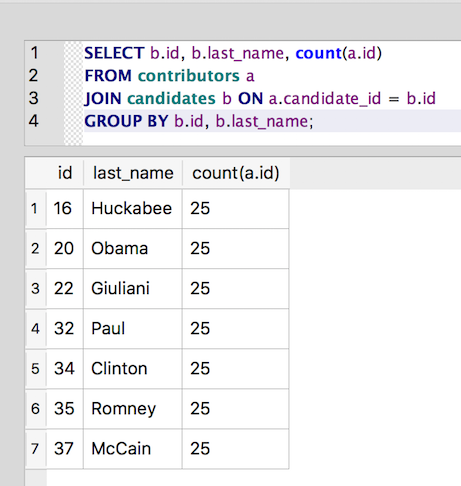Explicit JOIN syntax¶
In addition to the implicit join syntax, SQL includes an explicit
JOIN keyword. So, we could write the earlier query using this syntax instead:
SELECT contributors.last_name,
contributors.first_name,
candidates.last_name
FROM contributors
JOIN candidates ON contributors.candidate_id = candidates.id;
The query results should be the same as earlier, but using the JOIN
keyword makes the intent of the query more explicit.
Aliases work with JOIN as well:
SELECT a.last_name,
a.first_name,
b.last_name
FROM contributors a
JOIN candidates b ON a.candidate_id = b.id;
Now let’s try something a bit more interesting:
SELECT b.id, b.last_name, count(a.id)
FROM contributors a
JOIN candidates b ON a.candidate_id = b.id
GROUP BY b.id, b.last_name;

Excellent! We now know that we have 25 contributors for each candidate. Very cool. But, hey, wait. Our list of candidates seems to be coming up short. Let’s check it:
SELECT DISTINCT id, last_name FROM candidates;
The above query shows that we have 17 candidates total – in other words,
the JOIN query is missing 10 candidates. What going on here? SQLite has gone mad!
Actually, there’s a pretty sensible explanation for this result. We said
earlier that performing the JOIN would return the same results as the
query with this clause: WHERE contributors.candidate_id = candidates.id.
What if a candidate has no contributors? Then that candidate is not returned by the query.
The JOIN acts just like the WHERE clause and filters out any rows that
don’t match the condition defined. Joins that return only rows in which
there is a match in both tables are known as INNER JOINs.
This is often exactly the behavior you want from the join (ignore any rows from
either table that don’t relate to a row in the other table). So by
default, the JOIN keyword executes an INNER JOIN. You can also
explicitly request an INNER JOIN, just to make things clearer:
SELECT b.id, b.last_name, count(a.id)
FROM contributors a
INNER JOIN candidates b ON a.candidate_id = b.id
GROUP BY b.id, b.last_name;
The results will be the same.

A Gentle Introduction to SQL Using SQLite by Troy Thibodeaux is licensed under a Creative Commons Attribution-NonCommercial-NoDerivs 3.0 Unported License.